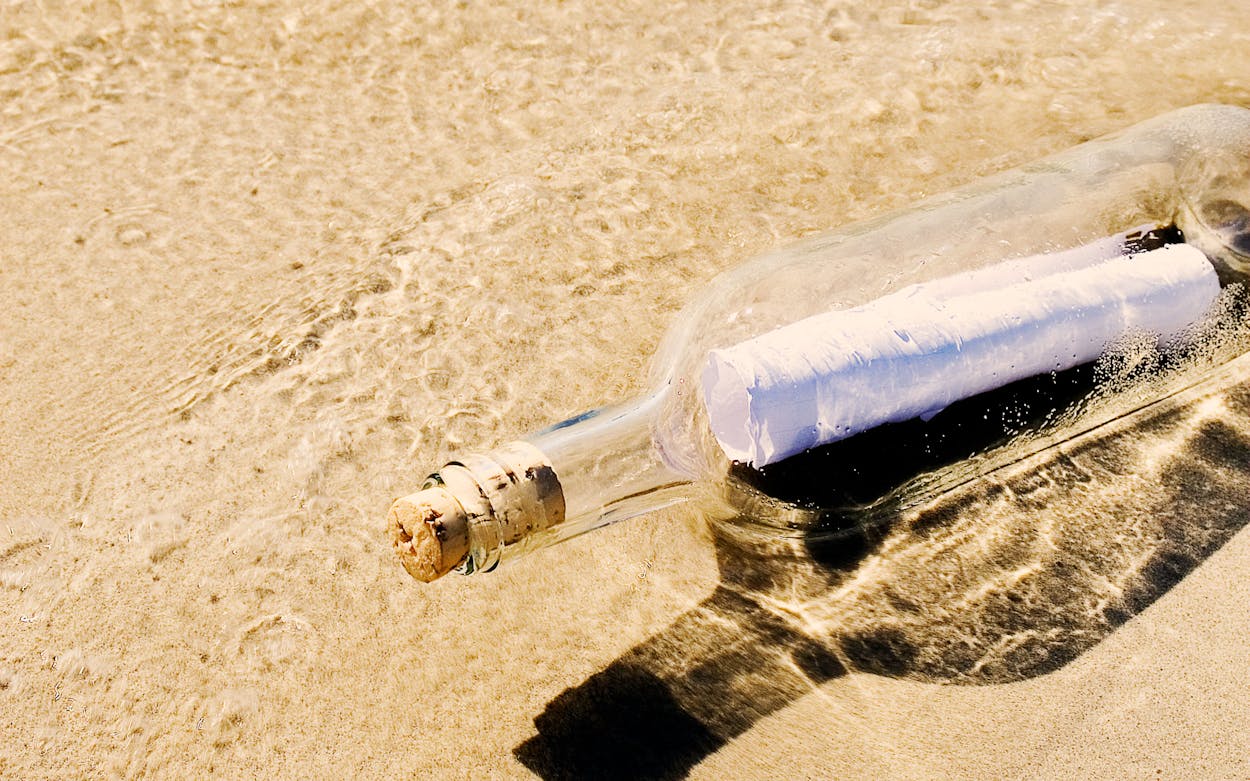In November 2018, a Canadian teenager named Lucas MacDonald wrote his name and phone number on a note while he was on his dad’s tuna-fishing boat off of Prince Edward Island, about 120 miles north of Halifax, Nova Scotia. He tucked the message inside a bottle and tossed it into the water, then forgot about it and went about his life.
Two and a half years later, on May 7, Dianne Jurek was visiting Matagorda Beach—a ninety-minute drive from her home in Fresno, south of Houston—when, according to the Canadian Broadcasting Corporation, she found a long glass object poking out of the sand. She retrieved the bottle, unearthed MacDonald’s note, and decided to send him a text to let him know that his bottle had made the journey from the Gulf of St. Lawrence to the Gulf of Mexico—a trip that would’ve meant traversing at least 2,800 miles on land.
The story is cute—who doesn’t love random chance and unlikely connections?—but MacDonald’s is not the only message in a bottle to turn up on the Texas Gulf Coast recently. Just a month before, in April, a beachgoer near Port Aransas found a bottle, likely originating in Cuba, that was stuffed with tobacco receipts and a two-page letter written in Spanish. It was the second such message to land on that beach in recent months; the first washed ashore in September after three years of drifting. (It was released in November 2017 by a Louisiana fourth grader as part of a science class.)
It’s not just Port A either. In May 2020, a Kingsville man stumbled upon a message launched five years earlier by a three-year-old from Maryland, who wrote it with the help of her parents while on vacation in the Cayman Islands. That message turned up in Corpus Christi, a few miles south of the Bob Hall Pier. When a Cayman Islands–based news outlet posted about the find, the girl’s father posted in the comments to identify himself and share his experience of sending the message.
Bottle messages don’t always come from the sea, though. In 2019 an East Texas man found a message in the river while on a hunting trip at Toledo Bend; it had been sent in 1988 from Carthage and likely spent a fair bit of the ensuing 31 years stuck under a logjam before it emerged. (The letter writer was identified by his granddaughter, who recognized his handwriting when the image was posted on Facebook.) A year later, another bottle stuffed with a message was discovered on the bank of the Neches River by two Beaumont boys. A man from Silsbee had launched it thirty years earlier while on a fishing trip with his son.
In 2019, meanwhile, a pair of beachgoers found a message with a longer pedigree but a less personal origin: a bottle launched in 1962 by what was then called the U.S. Bureau of Commercial Fisheries, as part of a study of ocean currents, that had washed ashore. (Such studies are now conducted by satellite.)
The odds of any given message in a bottle washing ashore aren’t great. A 2007 report from The American Surveyor found that less than 3 percent of messages tucked into bottles and sent adrift were ever discovered, which means that the handful that wash up on Texas beaches every few months likely represents just a tiny fraction of messages sent. Various factors appear to influence the chances of such a bottle surfacing—closer to shore is better than farther out, and bottles launched from densely populated areas tend to get recovered at a higher rate than ones dropped into the Arctic Ocean. But such is the romance of the message in a bottle: the possibility that it will ever be discovered is slim, which is what makes these stories so appealing. It’s fun to ponder how a handwritten note can be preserved in glass and transported through time and space by the great unknowable force that is the ocean.
A 2018 exhibit at the Houston Museum of Natural Science put our fascination with these missives on display, showcasing the collection of Illinois environmentalist Chad Pregracke, who’s discovered 64 messages in bottles during the course of his work with the river cleanup organization Living Lands and Waters. And it makes sense that the stories of these notes capture our imaginations. Each of us has a story, a need for connection, and a sense of whimsy. It’s a deeply human thing to share our thoughts, roll them up, and tuck them neatly inside a bottle in the hope that someone, somewhere, might someday find them. And, as it turns out, that happens more often than you might guess.
- More About:
- Port Aransas
- Matagorda








